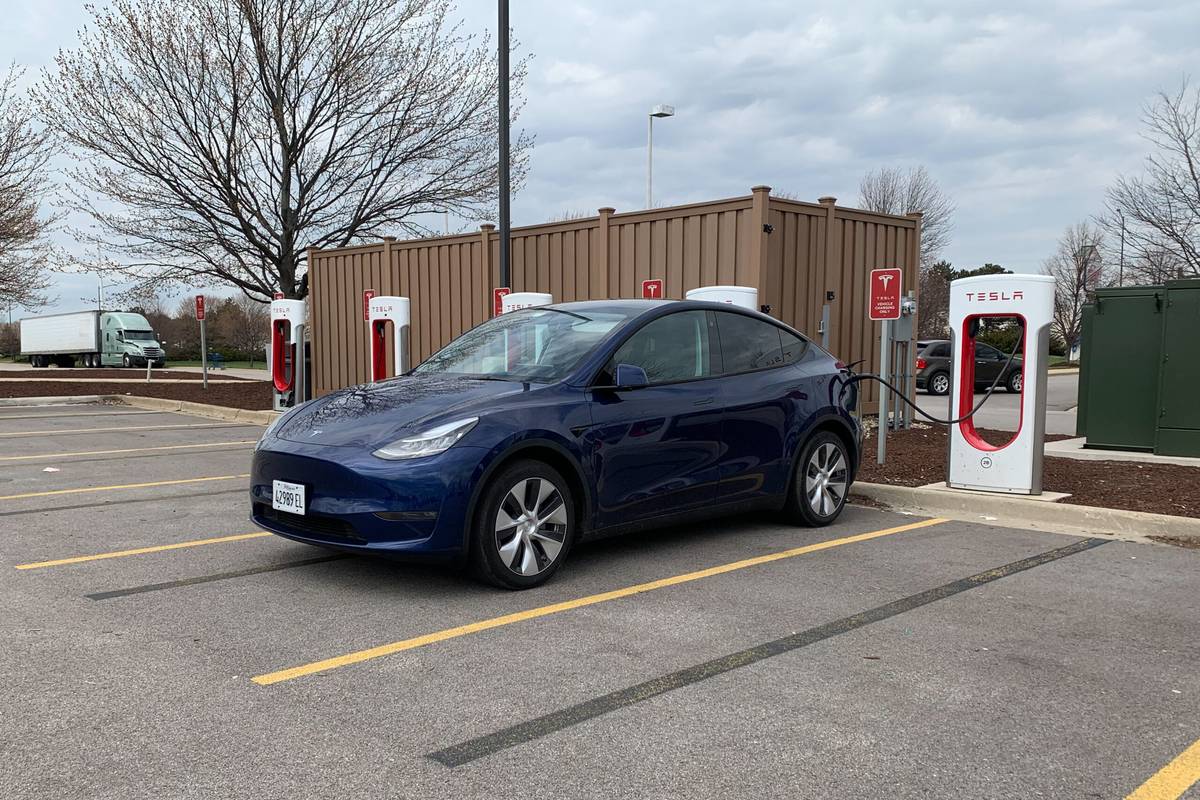Living Without a Home Charger With the Tesla Model Y


When purchasing an electric vehicle, how you’ll charge is a big consideration. The most ideal mode of charging is Level 2, 240-volt home charging, but not everyone has that option. I’m currently renting a house, and in my role as copy editor, I don’t have much of a need for a permanent home charger since I’m not regularly behind the wheels of our test cars. For those considering an EV without home charging, I wanted to share my experience driving our long-term 2021 Tesla Model Y Long Range All-Wheel Drive.
Related: More EV News and Advice
With the Model Y, I prefer to use Tesla’s Supercharger network because I’m never anywhere long enough to wait for a Level 2 charging session to complete, though such chargers are somewhat more accessible in my area.
The closest Supercharger to my home in the Chicago suburbs, meanwhile, is about 20 minutes away. The problem with this charger is that there’s basically nothing around it aside from an outdoors store that closes early, so I’m stuck sitting in my car for 25-30 minutes. I’d rather be productive — getting groceries or grabbing a bite to eat — while waiting for the Model Y to juice up, so I opt to go to the next closest Supercharger, which is 25-30 minutes away, located in a big-box store parking lot.
Our Model Y has an EPA-rated range of 326 miles, but many factors affect that number, the biggest being cold weather. When I had the Model Y in temperatures around 25-30 degrees Fahrenheit, the range dropped to about 220 miles. While this number of miles sounds like a lot in gas-only cars, it’s not in EVs; I always tell people, “There are real miles, and there are EV miles,” because an EV’s miles of range can drop faster than the actual distance traveled.
How Often I Charged

Between weeknight errands after work and hopping around the Chicago suburbs visiting family on weekends, I wound up charging the Model Y twice a week. This wouldn’t be much of a problem if I had a charger closer to my home, but trips to the Supercharger ate up to an hour and a half each time — 50 minutes to an hour in travel time plus another 25-30 minutes of charge time. If I had a Level 2 home charger, I could just plug it in at night and remove a whole lot of hassle.
I also used the Tesla Mobile Connector at my house, which is a portable charger that can plug into a standard three-prong outlet. My garage only has standard 120-volt outlets, so I knew from the get-go that the experience was going to be slow. After 20 long hours of charging, the Model Y only gained 71 miles of indicated range. I suppose this charging rate would suffice if I was adamant about keeping the car plugged in throughout the day while I worked and overnight, if there was no deviation in my driving distance and if 71 miles of indicated range always meant 71 miles of real driving range.
Would I Buy a Tesla Model Y Without Home Charging?
Having the Model Y as my daily driver felt like another item on my to-do list when it came to charging. Would that stop me from purchasing one without a home charger? Probably not, but I’d want my household to also have a gas-only or hybrid car for longer trips and the off chance someone didn’t plug in after use.
After my experience, here’s what I’d recommend shoppers consider before purchasing an EV without a home charger:
- Nearest charging location: How far is the nearest charger from your home? Determine how many miles and how much time going to the charger will require each week.
- Cost: While you dodge the fluctuating costs of gas, charging an EV at home or on the road still costs money, and DC fast charging (e.g., Tesla’s Supercharger network) is more expensive than charging at home. Check out our story on how much it costs to charge an electric car for more.
- Speed of the charging station and your vehicle: How long will you need to wait for your vehicle to charge?
- Surroundings: Is the nearest charger in a secluded location? Do you feel safe at the charger? Are there stores you can go into while you wait?
- How often you’ll need to visit the station: Consider your usage and try to determine how many times you’ll need to visit the station per week. If you have a long commute, you’ll likely be visiting chargers more often than someone who works locally.
- How DC fast charging affects the battery: DC fast charging can contribute to premature degradation of EV batteries and is best used sparingly, so Level 2 chargers are the best alternative. Unfortunately, these charging sessions can take anywhere from four to 15 hours to fully charge.
More From Cars.com:
- How Much Does It Cost to Charge an Electric Car?
- What It Cost to Outfit 6 Homes With EV Chargers
- Electric Vehicles: Understanding the Terminology
- EV Owners Frustrated by Public Charging, Says J.D. Power Study
- How to Find EV Charging Stations
- Which New Electric Vehicles Come With Free Charging?
Related Video:
Cars.com’s Editorial department is your source for automotive news and reviews. In line with Cars.com’s long-standing ethics policy, editors and reviewers don’t accept gifts or free trips from automakers. The Editorial department is independent of Cars.com’s advertising, sales and sponsored content departments.

Corinne Vercoe has been writing professionally for 10 years. She began producing and editing content for the automotive industry in 2018, joining Cars.com as Copy Editor in 2021. She is a member of the Midwest Automotive Media Association and inherited an interest in cars from her father, a lifelong Chevrolet Corvette enthusiast.
Featured stories




